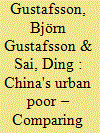| Srl | Item |
| 1 |
ID:
192330


|
|
|
|
|
| Summary/Abstract |
Using data from the China Household Income Project in 2013 and 2018, this paper studies relative poverty among rural hukou holders living in urban China and urban hukou holders. People living in households with an income below a fixed percent of the median per-capita income and wealth below the same fixed percent of the median per-capita wealth among urban residents are deemed as relative poor. Although migrants with rural hukou living in urban China were more prone to twice poverty than urban residents in 2013, this was not generally the case in 2018.
A multivariate analysis shows several factors to be related to the probability of being twice relative poor. Even considering these factors, a rural hukou status increased the probability of being twice relative poor in 2013. In contrast, such an excess risk of being twice relative poor was much lesser outspoken in middle and low-ranking cities in 2018. However, rural to urban migrants living in high-ranking cities had a somewhat higher risk of being relative poor than urban residents with the same characteristics in 2018.
|
|
|
|
|
|
|
|
|
|
|
|
|
|
|
|
| 2 |
ID:
159025


|
|
|
|
|
| Summary/Abstract |
The paper studies the levels and changes in wage inequality among Chinese rural-urban migrants during 2002–2007. Using data from two waves of national household surveys, we find that wage inequality among migrants decreased significantly between 2002 and 2007. Our analysis on the wage distribution further shows that the high-wage migrants experienced slower wage growth than middle- and low-wage migrants—a primary cause of declining inequality of migrants. By using distributional decomposition methods based on quantile regression, we find that an overall between-group effect dominates in the whole wage distribution, which means that the change in returns to the characteristics (education, experience and other employment characteristics) plays a key role, but on the upper tails of the wage distribution, the within group effect (residual effect) dominates, implying that the unobservable factors or institutional barriers do not favor the migrants at the top tail of the wage distribution. We also study wage differential between migrants and urban natives, and find that though the wage gap is narrowed, the gap at the upper wage distribution is becoming bigger. Overall, the results suggest that there exists a strong “glass ceiling” for migrants in the urban labor market.
|
|
|
|
|
|
|
|
|
|
|
|
|
|
|
|